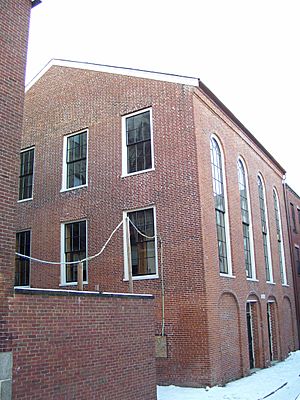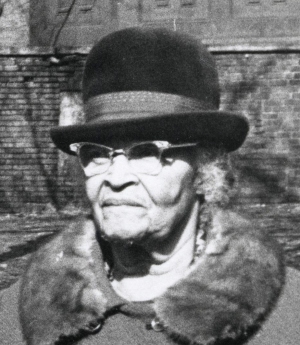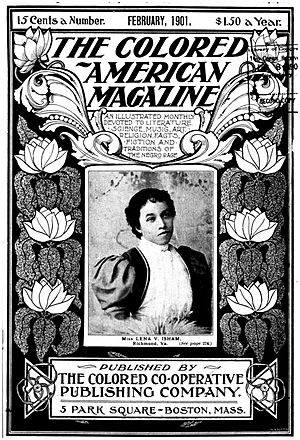History of African Americans in Boston facts for kids
African Americans have been a small but very important group in Boston's history. Even though they were a minority and faced unfair treatment in housing, education, and other areas, they have made huge contributions to Boston's arts, politics, and businesses since colonial times. Today, about 28% of Boston's population identifies as Black or African American.
Contents
- History of African Americans in Boston
- Early America: First Arrivals and Freedom Fighters
- Abolitionism: Fighting for Freedom
- Late 19th Century: Gaining a Voice
- Early 20th Century: A Time of Creativity and Activism
- Civil Rights: The Fight for Equality
- Busing: Desegregating Schools
- Late 20th Century: Media and Community Growth
- 21st Century: New Leaders Emerge
- Popular Culture
- Demographics
- Notable African Americans
- African-American Organizations
History of African Americans in Boston
Early America: First Arrivals and Freedom Fighters

The first recorded African Americans arrived in Boston in 1638 as enslaved people on a ship called Desiré. They came from New Providence Island in the Bahamas. Others might have arrived even earlier.
The first Black person to own land in Boston was Bostian Ken in 1656. He bought his own freedom and then helped another enslaved person gain freedom by mortgaging his property. Zipporah Potter Atkins also bought land in 1670.
A small community of free African Americans lived near Copp's Hill from the 1600s to the 1800s. Some of their gravestones can still be seen at the Copp's Hill Burying Ground. By 1720, about 2,000 African Americans lived in Boston.
In 1767, 15-year-old Phillis Wheatley published her first poem. This was a big deal because she was the first African American to publish a poem in the American Colonies. Wheatley was an enslaved person from Senegal. You can see a sculpture of her, along with Abigail Adams and Lucy Stone, in the Boston Women's Memorial.
The first person killed in the American Revolutionary War was Crispus Attucks in 1770 during the Boston Massacre. He was of African and Wampanoag descent. Slavery was ended in Massachusetts in 1781, partly because many Black people fought bravely in the Revolutionary War. After this, a large community of free Black people and those who had escaped slavery grew in Boston.
Many Black Bostonians fought in the Revolutionary War, including Primus Hall, Barzillai Lew, and George Middleton. African Americans like Peter Salem, Salem Poor, and Seymour Burr also fought in the Battle of Bunker Hill.

Abolitionism: Fighting for Freedom
Boston was a major center for the abolitionist movement, which worked to end slavery. In the 1800s, many African-American abolitionists lived in the West End and on Beacon Hill. These included John P. Coburn, Lewis Hayden, David Walker, and Eliza Ann Gardner.
Boston had several abolitionist groups. The Massachusetts Anti-Slavery Society featured speakers like Frederick Douglass. The Boston Female Anti-Slavery Society included author Susan Paul. Abolitionists often met at the African Meeting House on Beacon Hill. The Twelfth Baptist Church, led by Rev. Leonard Grimes, was known as "The Fugitive Slave Church" because it helped people escape slavery.
Several times, people in Boston helped enslaved individuals escape. In 1836, Eliza Small and Polly Ann Bates were freed by a crowd in a courtroom. The 1843 Liberty Act was passed, stopping the arrest of people who had escaped slavery in Massachusetts. Abolitionists also helped Ellen and William Craft in 1850, Shadrach Minkins in 1851, and Anthony Burns in 1854.
White Bostonians like William Lloyd Garrison, who started the Liberator newspaper, also joined the abolitionist movement. Senator Charles Sumner from Boston was nearly killed for speaking out against slavery in 1856.
The 54th Massachusetts Infantry Regiment was one of the first official African-American military units during the American Civil War. Frederick Douglass helped recruit soldiers for this regiment at the African Meeting House. Sergeant William H. Carney, a member of the 54th, won the Medal of Honor for his bravery. His face is on the monument to Robert Gould Shaw and the 54th on the Boston Common.
The Black Heritage Trail in Boston visits the African Meeting House and other important sites on Beacon Hill that tell the story of Black history before the Civil War. The Boston Women's Heritage Trail also honors women like Rebecca Lee Crumpler, the first African-American woman doctor, and the poet Phillis Wheatley. Harriet Tubman, a famous abolitionist, often visited Boston.
Late 19th Century: Gaining a Voice
After the Civil War, the West End remained a key area for African-American culture. It was one of the few places in the United States where African Americans had a political voice. From 1876 to 1895, at least one Black resident from the West End served on Boston's community council every year.
In 1878, Horatio J. Homer became the Boston Police Department's first African-American officer. He served for 40 years.
In 1895, Boston hosted the First National Conference of the Colored Women of America.
Early 20th Century: A Time of Creativity and Activism
Boston played a big part in Black cultural expression during the Harlem Renaissance period. Political writers and activists like William Monroe Trotter, Josephine St. Pierre Ruffin, and Angelina Weld Grimké continued Boston's tradition of Black activism. Boston had a group of educated Black leaders, sometimes called Black Brahmins, who pushed for racial equality. Josephine St. Pierre Ruffin edited The Woman's Era, the first newspaper published by and for African-American women. She also started the Woman's Era Club, the first club for African American women in Boston.
In theater, Ralf Coleman was known as the "Dean of Boston Black Theater." In dance, Stanley E. Brown, Mildred Davenport, and Jimmy Slyde became famous. Allan Crite was a very important painter in Boston.
The Colored American Magazine, one of the first magazines for African Americans, was first published in Boston. Pauline Hopkins wrote for and edited the magazine. William Stanley Braithwaite's Anthology of Magazine Verse helped shape American poetry.
The Saturday Evening Quill Club was a Black literary group started in 1925 by Eugene Gordon. Members included writers like Pauline Hopkins, Dorothy West, and Florida Ruffin Ridley. Their journal, Saturday Evening Quill, published works by African-American women and gained attention from writers in New York.
In 1900, Booker T. Washington founded the National Negro Business League in Boston to help Black business owners. In 1910, David E. Crawford opened the Eureka Co-Operative Bank, which was the only bank in the East owned and run by "Colored People."
In the first half of the 1900s, Boston's Black community grew and became more diverse. People moved to Boston from the West Indies, Cape Verde, and the American South and West, including Malcolm X. The community began to expand from the South End into Roxbury. In 1949, social workers Otto P. Snowden and Muriel S. Snowden founded Freedom House in Roxbury.
Civil Rights: The Fight for Equality

Boston's civil rights history is very important, even if it's not as widely known as other places. People like Melnea Cass were active in the civil rights movement long before the busing debates of the 1970s. In 1963, 8,000 people marched through Roxbury to protest unfair segregation in Boston's public schools. In April 1965, Martin Luther King Jr. led a march from Roxbury to Boston Common to protest school segregation. That June, Massachusetts passed a law ordering public schools to desegregate.
After Martin Luther King Jr. was assassinated in 1968, Mayor Kevin White asked James Brown not to cancel a concert in Boston. The concert was televised to encourage people to stay home and prevent unrest. The next day, nearly 5,000 people attended a rally organized by the Black United Front. They demanded that Black communities control their own businesses, schools, and local agencies.
In September 1968, 500 African-American students walked out of school after a student was sent home for wearing a dashiki, a traditional African garment. Later that year, Mel King and the New Urban League protested, saying that Boston's African-American community was not getting enough resources.
Busing: Desegregating Schools
From 1974 to 1988, Boston public schools were under court order to desegregate. This meant using a system of busing students between different areas of the city. The goal was to create more balanced schools. This period led to protests and drew national attention, especially from 1974 to 1976. The court's plan lasted over a decade and changed Boston's politics and population. Many white families moved to the suburbs, and public school enrollment declined. By 1988, the Boston School Committee regained control of the desegregation plan. In 2013, the busing system was changed to reduce the amount of busing needed.
Late 20th Century: Media and Community Growth
In 1968, WGBH-TV started Say Brother, later called Basic Black. This is Boston's longest-running public affairs show made by and for African Americans. In 1972, Sheridan Broadcasting bought the WILD (AM) radio station, making it the only urban music station in the country owned by a Black company.
In the 1970s, many Jewish residents moved out of the Mattapan area.
The Elma Lewis School of Fine Arts began its annual performance of the Black Nativity in 1970. This show has been performed at various theaters in Boston ever since.
In 1972, the Museum of African American History bought the African Meeting House on Beacon Hill, preserving this important landmark.
From 1974 to 1980, the Combahee River Collective, a group of Black lesbian socialists, met in Boston. They created the Combahee River Collective Statement, a key text for Black feminism.
In 1978, the Boston branch of the NAACP successfully sued the U.S. Department of Housing and Urban Development for allowing housing discrimination in Boston. Even after this, a 1989 report found that Black neighborhoods in Boston were less likely to receive home mortgages than white neighborhoods.
In 1986, some activists proposed that predominantly Black neighborhoods in Boston should form a new city called Mandela. Voters in those neighborhoods rejected the idea.
Nelson Mandela and his wife Winnie Madikizela-Mandela visited Boston on June 23, 1990.
In 1996, George Walker's Lilacs, for Voice and Orchestra was performed by the Boston Symphony Orchestra. Walker won a Pulitzer Prize for Music for this piece, becoming the first African-American composer to receive the award.
21st Century: New Leaders Emerge
In 2009, Ayanna Pressley made history as the first Black woman, and first woman of color, elected to the Boston City Council. In 2018, she became the first woman of color to represent Massachusetts in Congress. In 2021, Kim Janey became the first African-American mayor of Boston.
Popular Culture
- Donna Summer
- Blue Hill Avenue, 2001 film
- New Edition
Demographics
Based on information from 2010–2014, about 180,657 people in Boston (28.2% of the population) are Black or African American, either alone or mixed with another race.
| Number | % of Boston population | |
|---|---|---|
| Black/African American | 180,657 | 28.2% |
| Black/African American alone | 160,342 | 25.1% |
| Black/African American and White | 14,763 | 2.3% |
| Black/African American and American Indian/Alaska Native | 943 | .1% |
Most Black/African American people in Boston (about 145,112) are not Hispanic.
Notable African Americans
| 1600s-1900s |
|---|
|
| Early 20th Century |
|---|
|
| Later 20th and 21st Centuries |
|---|
|
Alumni: People Who Studied in Boston
Many famous African Americans who grew up elsewhere came to Boston for college and careers. For example, Quincy Jones and Esperanza Spalding studied music at Berklee College of Music. Martin Luther King Jr. earned his PhD at Boston University. The pioneering psychiatrist Dr. Solomon Carter Fuller studied at Boston University School of Medicine. Harvard University in Cambridge has also graduated many notable African Americans, including W. E. B. Du Bois and Neil deGrasse Tyson.
African-American Organizations



